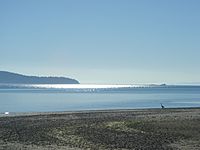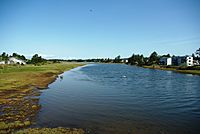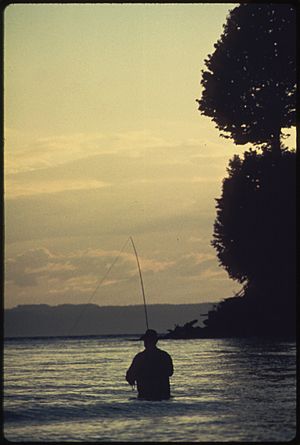Coastal cutthroat trout facts for kids
The coastal cutthroat trout (Oncorhynchus clarkii clarkii) is a special type of cutthroat trout. People also call it the sea-run cutthroat trout. This fish lives in Western North America.
Coastal cutthroat trout come in different forms. The most famous type is the "sea-run" form. These fish live in the ocean for part of their lives. Other types live only in freshwater, like rivers, streams, and lakes.
You can find these trout from the southern coast of Kenai Peninsula in Alaska all the way down to the Eel River in Northern California. They usually stay close to the Pacific Ocean, rarely going more than 100 miles (160 km) inland.
Adult coastal cutthroat trout travel from the ocean to freshwater to lay their eggs. Young fish then go to the sea to grow up. They become mature there before returning to freshwater to spend the winter and lay their own eggs. Unlike steelhead or Pacific salmon, these trout do not travel far into the open ocean. They usually stay within 5 to 10 miles (8 to 16 km) of their home stream. Some have been known to travel up to 70 miles (110 km) into the ocean.
There are also populations that live their whole lives in lakes or rivers. For example, the trout in Lake Crescent in Washington state live only in that lake.
Contents
About Their Name
Cutthroat trout were named Salmo clarkii to honor William Clark. He was a leader of the famous Lewis and Clark Expedition (1804–1806). One goal of their trip was to describe new plants and animals.
A naturalist named John Richardson first described this fish. He found it in a river that flows into the lower Columbia River. This fish was most likely the coastal cutthroat subspecies.
Later, in 1989, scientists studied these trout. They found that trout from the Pacific Ocean area were more closely related to Pacific salmon than to other trout like brown trout or Atlantic salmon. Because of this, scientists moved the rainbow trout, cutthroat trout, and other Pacific trout into a new group called Oncorhynchus.
What They Look Like
Freshwater coastal cutthroat trout are usually dark green or bluish on their backs. Their sides are olive-green, and their bellies are silvery. They have many spots below their side line. Their fins also have irregular spots. Their gill covers often look pinkish.
Sea-run forms look different when they are in saltwater or just back from the ocean. They are silvery with a bluish back. Their lower sides and fins are yellowish, and they have fewer spots.
Cutthroat trout usually have special red, pink, or orange marks. These marks are found under their jaws, in the lower folds of their gill plates. These marks are why they are called "cutthroat." An outdoor writer named Charles Hallock gave them this name in 1884. However, these red marks are not only found on cutthroat trout. Some rainbow trout can have them too.
Sea-run coastal cutthroat trout usually weigh about 2 to 5 pounds (0.9 to 2.3 kg). Trout that live in streams are much smaller, weighing only about 0.4 to 3.2 ounces (11 to 91 g).
Their Life Cycle
Coastal cutthroat trout usually live and lay eggs in small to medium-sized rivers. These rivers are clear, have plenty of oxygen, and have gravel bottoms. They are found in the natural rivers that flow into the Pacific Ocean.
They typically lay their eggs from December to June, with most eggs laid in February. Eggs start to hatch about six to seven weeks after being laid. Spawning begins when the water temperature is about 43 to 46°F (6 to 8°C).
Depending on the temperature, young fish called alevins come out as fry between March and June. Most come out in mid-April.
Lake-dwelling coastal cutthroat trout prefer moderately deep, cool lakes. These lakes need good shallow areas and plants for food. Lake populations usually need access to gravel-bottomed streams to lay their eggs. Sometimes, they can lay eggs on shallow gravel beds in the lake if the water moves well.
Cutthroat trout can sometimes breed with rainbow trout. This creates fertile hybrids called "cutbows." However, this is quite rare for coastal cutthroat trout. This is because coastal cutthroat trout and coastal rainbow trout have lived together for a very long time. They have developed ways to keep their groups separate when breeding. When these hybrids do appear, they often look like cutthroat trout, even keeping the red slash. This can make them hard to identify.
Where They Live and Their Home
The coastal cutthroat trout's natural home stretches from the southern coast of the Kenai Peninsula in Alaska to the Eel River in Northern California. These fish live in streams and rivers that flow into the Pacific Ocean. They usually stay within 100 miles (160 km) of the ocean.
You can find them in many different places. This includes the upper and lower parts of large and small rivers, estuaries (where rivers meet the sea), ponds, lakes, and ocean waters near the shore. They spend more time in freshwater than other salmon-like fish that travel to the ocean.
In freshwater, they like deeper pools and places to hide, like under fallen trees. The sea-run forms do not stay in saltwater during winter. They also rarely travel long distances across large bodies of water. Their ocean travels are usually within 6 miles (10 km) of land.
Sea-run coastal cutthroat trout typically spend two to five years growing up in freshwater. After this, they make their first trip to saltwater. They usually spend short periods offshore during summer. Then, they return to estuaries and freshwater by fall or winter.
How They Are Doing
The coastal cutthroat trout is a healthy subspecies of cutthroat trout. Even though their numbers have gone down since the 1800s, none of the populations in the United States or British Columbia are considered endangered or threatened.
The United States Fish and Wildlife Service and other groups have identified ten special population groups from Alaska to California. In 1999, they looked closely at these groups. They thought about listing one group, the Southwestern Washington/Columbia River group, as threatened. However, after more study and public comments, they decided in 2002 not to list it as threatened.
The trout that live only in streams, rivers, and lakes are also doing well. Their numbers are helped by stocking fish raised in hatcheries in Washington and Oregon.
See also
 In Spanish: Oncorhynchus clarkii clarkii para niños
In Spanish: Oncorhynchus clarkii clarkii para niños






